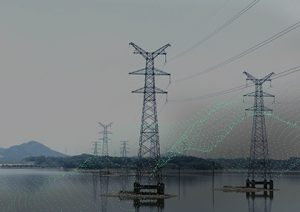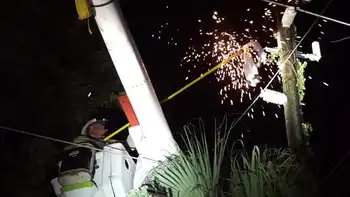As wind power grows, a push to tear down dams
By New York Times
High Voltage Maintenance Training Online
Our customized live online or in‑person group training can be delivered to your staff at your location.

- Live Online
- 12 hours Instructor-led
- Group Training Available
Now, with the focus in Washington on clean power, some dam agencies are starting to go green, embracing wind power and energy conservation. The most aggressive is the Bonneville Power Administration, whose power lines carry much of the electricity in the Pacific Northwest. The agency also provides a third of the regionÂ’s power supply, drawn mostly from generators inside big dams.
The amount of wind power on the Bonneville transmission system quadrupled in the last three years and is expected to double again in another two. The turbines are making an electricity system with low carbon emissions even greener — already, in Seattle, more than 90 percent of the power comes from renewable sources.
Yet the shift of emphasis at the dam agencies is proving far from simple. It could end up pitting one environmental goal against another, a tension that is emerging in renewable-power projects across the country.
Environmental groups contend that the Bonneville Power AdministrationÂ’s shift to wind turbines buttresses their case for tearing down dams in the agencyÂ’s territory, particularly four along the lower Snake River in Washington State that helped decimate one of North AmericaÂ’s great runs of wild salmon.
Bonneville wants to keep all the dams, arguing that they not only provide cheap power but they also make an ideal complement to large-scale installation of wind power. When the wind slows and power production drops, the agency argues, it can compensate quickly by telling the Army Corps of Engineers and the Bureau of Reclamation, which operate the dams, to release more water from reservoirs to turn the huge generators.
When the wind picks up, dam operations can be slowed.
The dams help alleviate a need for natural-gas-fired power plants, which are used in other regions as a backup power source when the wind stops blowing, but which release carbon dioxide that contributes to global warming.
By balancing wind power with hydropower, the Bonneville Power Administration says it believes it can limit the use of natural gas and coal plants across the West, even as the region’s demand for electricity rises. Around the country, dams provide 6 percent of electricity generation — double the amount from other renewable sources like wind, solar power and biomass — and much of that is concentrated in the West.
The influx of wind on BonnevilleÂ’s system has come as a result of renewable power goals set by governments in the Western states, which aim to reduce their output of greenhouse gases. Bonneville says that when the wind is blowing most strongly, 18 percent of the power in its control area now comes from wind, and that number may rise to 30 percent next year. (Not all of that is consumed in the Pacific Northwest; some is sold to California.)
The rise in wind power means that the dam agency has emerged as a national test case for how to integrate large amounts of intermittent wind power into a regional electric grid. “I’ve described this as a grand experiment,” said Stephen J. Wright, the administrator of the 72-year-old Bonneville Power Administration.
The agency stresses the challenge it faces, making sure the lights stay on despite the ups and downs of the wind. Many new wind farms lie along the gusty Columbia River corridor, and their concentration means that changes in the wind can bring sudden dips and spikes in the power they generate.
“We can have periods that go from full, maximum wind output to zero across an hour,” Mr. Wright said.
Because of its erratic nature, wind power — and the need for dams or other backup systems — has become intertwined with the fate of salmon, perhaps the biggest environmental controversy in the Pacific Northwest.
For decades, environmentalists, fishermen and some local politicians, who want to save the endangered salmon, have fought Bonneville and the Army Corps of Engineers, which want to keep the lower Snake River dams. A federal judge overseeing the dispute has accused the federal agencies of not working hard enough to save the salmon and had raised the possibility of breaching those dams to aid the fish.
Wild salmon ride the river in two directions. They spawn far upstream, and the young fish swim downriver to the Pacific Ocean. They spend several years there, feeding and growing quite large, before swimming back upstream to spawn and die.
The large reservoirs created over the decades as the dams were built have slowed and complicated their journeys, and slashed survival rates. Fish ladders help on the way back upstream, but those salmon that get through in both directions end up traumatized and weakened, biologists say.
When it comes to helping salmon, Bonneville has “been dragged kicking and screaming every inch of the way,” said Bill Arthur, a Sierra Club representative in the Northwest. Mr. Arthur praised the agency’s efforts to add wind power, but he argued that the four lower Snake River dams, which are far smaller than major dams like Grand Coulee, were not needed to back up wind power.
Instead, he proposed putting wind turbines in more places, to help balance power generation by ensuring that some are always in an area where the wind is blowing, or relying more on the NorthwestÂ’s natural gas plants in combination with energy-saving measures. He also noted that if the dams came down, dismantling them could take six or more years, allowing plenty of time to plan the transition to new power sources.
Elliot Mainzer, vice president for corporate strategy at the Bonneville Power Administration, said that tearing down the Snake River dams would “unequivocally” hurt the ability of the agency to assimilate wind power into its system, because of the dams’ role in balancing up-and-down wind generation.
Even as the salmon controversy plays out, the agency is seeking to build more power lines to speed wind-farm development in remote, windy areas.
The economic stimulus package passed in February will help: it sharply increased the maximum amount that the agency can borrow from the United States Treasury to $7.7 billion, from $4.45 billion. (Another dam agency, the Western Area Power Administration, got a similar boost and also plans more transmission lines to aid wind and other renewables.)
Bonneville says that the stimulus injection will enable it to build a $246 million transmission project along the Columbia River, allowing developers to put up wind turbines in additional areas of eastern Oregon, and that more planned transmission lines will also help harness the wind.
All of that is good news for the areaÂ’s farmers, some of whom welcome a new source of income.
John Hildebrand, an animated 82-year-old wheat farmer, has allowed a Spanish developer, Iberdrola, to put wind turbines on his land in Wasco, not far from the Columbia River. Power from his turbines feeds into the Bonneville system.
He and his brother Gordon sat in the front row when Franklin D. Roosevelt dedicated the Bonneville Dam in 1937, before the region even had public power — so they have seen the future of energy, twice.
“All we had is sky out there,” John Hildebrand said, looking out toward the tall structures twirling high above his rolling land. “Now I’ve got turbines.”











